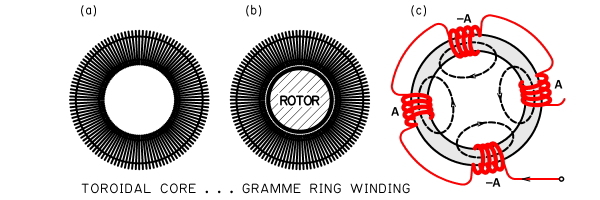Recently the U.K. Magnetics Society sent a list of 10 questions for their magazine MagNews, in which the first question was “What is your favourite magnetic material?” In a hurry, I replied “Fresh air. No magnetic circuit can work without it. And you can breathe it.”
I forgot about it until the magazine arrived in my letterbox, and there it was in print. I realised too late that my statement isn’t true. Some magnetic circuits do work without fresh air. They include the ones that work in a vacuum. In another issue of MagNews (2017/1) we can read about a special motor EC22HD developed by Maxon for operation in “the extreme vacuum conditions of a synchrotron”. There must be transformers and motors operating in spacecraft, presumably in vacuum in many cases.
This made me think: What does air really do in magnetic circuits? Whatever it does, vacuum must perform essentially the same function. So let’s begin with a simple magnetic device: a toroidal coil with a uniform winding on a ferromagnetic core. Does air have any role in its functioning?
Referring to the figure, in (a) we see a toroidal coil with a uniform winding. The flux lines are concentric circles entirely within the core. Even if the core saturates, or is removed completely, there is no tendency for the flux to leak outside the winding.
This being the case, if we put a rotor inside the toroid (b), it will not link any flux. There is no possibility that it will work as a motor.
To make a motor out of this device, it is necessary to divide the winding into sections, with half the sections wound in opposition to the others. We see this in (c). The flux is now forced out of the core, passing out in loops both inside and outside the ring. If the rotor is ferromagnetic, it will carry most of the flux that “leaks” out of the core.
So here in (c) we have a magnetic circuit where “fresh air” carries the flux from the toroidal stator to the rotor inside it. Would it work in a vacuum? Yes! But without the “air-paths” it would not work at all.
We can say that the air-paths are necessary for this magnetic circuit to work. Does it mean that they do the job efficiently? Not at all : because of the low permeability of air (or vacuum), we need so many more ampere-turns in the stationary field winding on the stator. But we cannot escape from the need for air-paths.
The machine in (c) is the Gramme ring configuration, which was used for 20 or 30 years in serious production of DC motors and generators before the drum armature was invented. It has been obsolete for a long time, but when we look at a modern machine with windings in slots and a definite airgap, it is even more obvious that the airgap is essential. For all sorts of reasons — both mechanical end electrical — the airgap cannot be made zero, much as we might like to get rid of it. The airgap can be seen as a kind of rubbish bin which collects all the manufacturaing tolerances and much of the heat that comes off the rotor and the stator. But we cannot get rid of it, and in that sense maybe what I should have said in my answer was that “air is an essential element in most working magnetic circuits”. The emphasis here is on working, in the sense of converting electrical energy into mechanical work. Transformers are another story. Am I excused for my hasty answer? Probably not!







